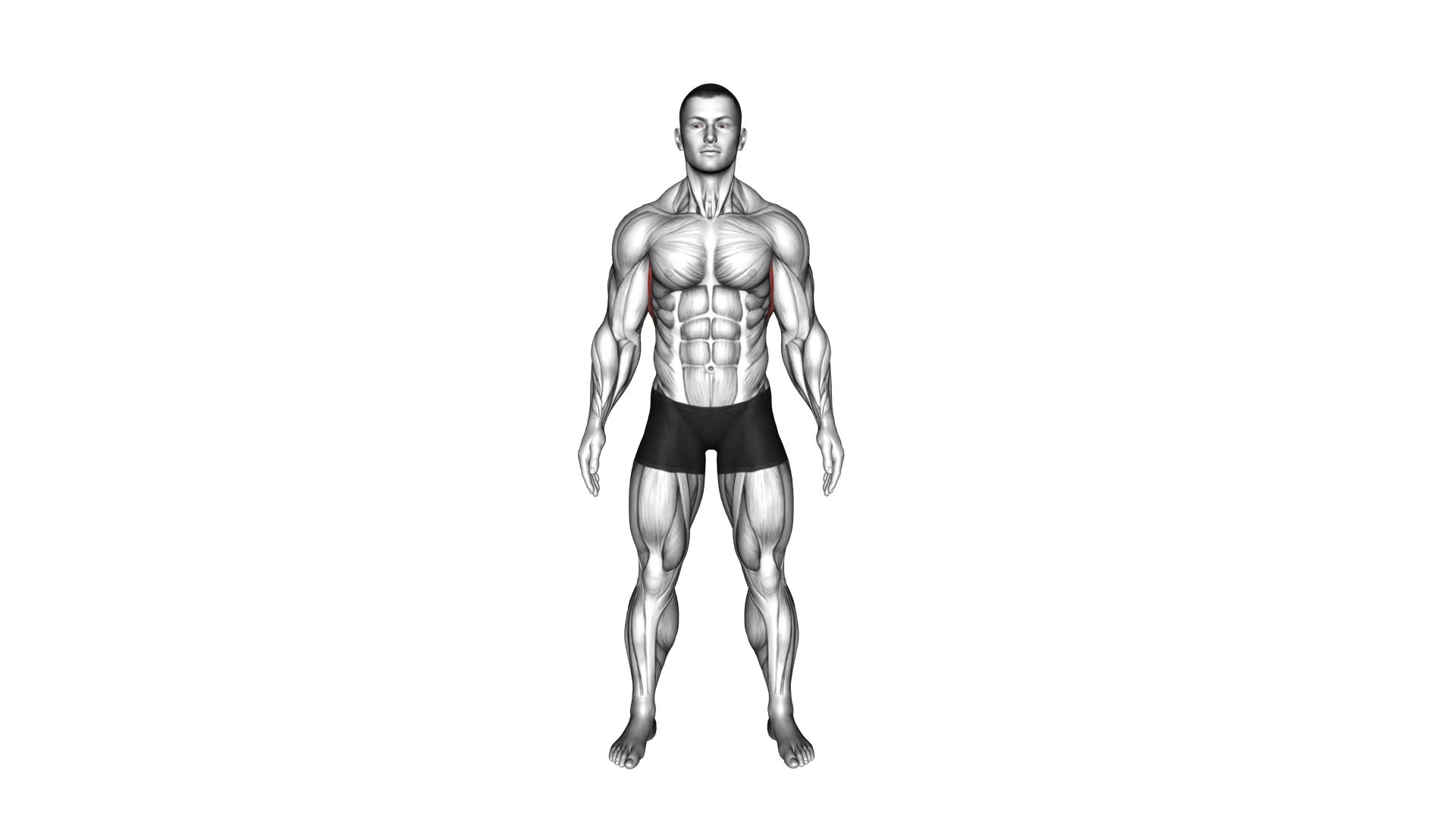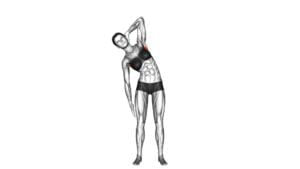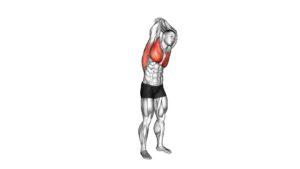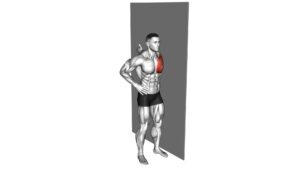Standing Lateral Stretch – Video Exercise Guide & Tips

Are you looking for a quick and effective way to stretch your sides? Look no further than the Standing Lateral Stretch!
Watch This Exercise Video
In this video exercise guide, we'll show you the proper form and technique to get the most out of this stretch. We'll also cover variations and modifications to suit your needs, as well as tips for maximizing your results.
Don't miss out on this valuable stretch that can help improve flexibility and relieve tension. Let's get started!
Key Takeaways
- The standing lateral stretch improves flexibility and range of motion.
- It targets the obliques, hips, and lower back muscles.
- The exercise enhances athletic performance and reduces muscle soreness.
- Proper form and technique include standing with feet hip-width apart, extending arms overhead, engaging core muscles, and slowly leaning to each side.
Benefits of the Standing Lateral Stretch
To experience the benefits of the Standing Lateral Stretch, you can improve flexibility and strengthen the muscles in your sides. Incorporating lateral stretches into your workout routine is a great way to target the muscles in your obliques, hips, and lower back. These stretches involve a side-to-side movement, which helps to elongate and stretch these muscle groups.
Stretching techniques for improved flexibility are essential for maintaining overall body health and preventing injuries. The Standing Lateral Stretch specifically targets the muscles in your sides, helping to increase your range of motion and improve your overall flexibility. By regularly incorporating this stretch into your routine, you can enhance your athletic performance and reduce muscle soreness after a workout.
In addition to flexibility, the Standing Lateral Stretch also helps to strengthen the muscles in your sides. As you lean to one side and hold the stretch, you engage your obliques and other lateral muscles, which helps to build strength and stability. This can be especially beneficial for activities that require rotational movements, such as golf, tennis, or even everyday tasks like twisting and bending.
Proper Form and Technique for the Exercise
Now let's focus on the proper form and technique for the Standing Lateral Stretch to ensure maximum effectiveness and safety. To perform this exercise correctly, follow these guidelines:
- Stand with your feet hip-width apart and your knees slightly bent.
- Extend your arms overhead, keeping them straight and parallel to each other.
- Engage your core muscles by drawing your belly button in towards your spine.
- Slowly lean to one side, keeping your upper body in a straight line and avoiding any twisting or bending at the waist.
- Hold the stretch for about 20-30 seconds, feeling a gentle stretch on the opposite side of your body.
- Return to the starting position and repeat the stretch on the other side.
Common misconceptions about the Standing Lateral Stretch include:
- It isn't necessary to touch your toes or reach a certain level of flexibility. The goal is to feel a comfortable stretch along the side of your body.
- Avoid any jerky or sudden movements. Smooth and controlled motions are key to prevent injury.
Precautions and safety measures to keep in mind while performing this exercise include:
- Listen to your body and only stretch to a point that feels comfortable. Don't push yourself beyond your limits.
- If you have any pre-existing conditions or injuries, consult with a healthcare professional before attempting this exercise.
- Always warm up your body before stretching to reduce the risk of muscle strain or injury.
Variations and Modifications to Try
You can easily modify the Standing Lateral Stretch by incorporating different arm positions. By adjusting your arm placement, you can target different muscles and add variation to your stretching routine.
One modified position you can try is extending one arm overhead while performing the stretch. This will increase the stretch on the opposite side of your body and target the muscles in your side and shoulder.
Another option is to position your arms in a goalpost shape, with your elbows bent at a 90-degree angle and your palms facing forward. This variation will engage your chest and upper back muscles, providing a deeper stretch in those areas.
Additionally, you can explore alternative stretches that work similar muscle groups. For example, the Seated Side Bend stretch can be an effective alternative, as it also targets the side muscles while seated on a chair.
Remember to listen to your body and choose the modified positions or alternative stretches that feel comfortable and effective for you.
Tips for Maximizing Your Results
For optimal results, focus on maintaining proper form and breathing throughout the Standing Lateral Stretch. Here are some tips to help you maximize your results:
- Effective breathing techniques:
- Take deep breaths in through your nose and exhale fully through your mouth. This will help you relax and engage your core muscles more effectively.
- As you stretch to the side, inhale deeply to expand your ribcage and create space in your torso. Exhale as you return to the starting position, allowing your body to release tension.
Incorporating the standing lateral stretch into a full body workout routine:
- Start with a warm-up to prepare your muscles for the stretch. This can include light cardio exercises like jogging or jumping jacks.
- Perform the standing lateral stretch after your warm-up and before your main workout. This will help improve your flexibility and increase blood flow to your muscles.
- If you're doing a full body workout, consider adding the standing lateral stretch between sets of other exercises. This will provide a brief recovery period and help prevent muscle tightness.
Common Mistakes to Avoid
To avoid common mistakes, prioritize maintaining proper form and breathing throughout the Standing Lateral Stretch.
One of the most common mistakes people make is leaning too far forward or backward during the stretch. This can put unnecessary strain on your lower back and compromise the effectiveness of the exercise.
Another common mistake isn't engaging your core muscles. Your core plays a crucial role in supporting your spine and maintaining balance. By neglecting to engage your core, you not only miss out on the full benefits of the exercise but also increase the risk of injury.
Additionally, it's important to avoid holding your breath while performing the Standing Lateral Stretch. Holding your breath can cause tension to build up in your muscles and limit your range of motion. Instead, focus on breathing deeply and exhaling as you reach towards the side.
Frequently Asked Questions
How Many Repetitions Should I Do for the Standing Lateral Stretch?
To determine the repetition range for the standing lateral stretch, consider your fitness level and goals. As a beginner, start with 8-12 repetitions per set. Gradually increase the number of sets as you become more comfortable.
Remember to listen to your body and make modifications if needed. This exercise targets the side muscles of the body, improving flexibility and posture.
Always consult with a fitness professional for personalized advice.
Can I Do the Standing Lateral Stretch if I Have a Previous Shoulder Injury?
Yes, if you have a previous shoulder injury, modifications can be made to the standing lateral stretch. It's important to listen to your body and avoid any movements that cause pain or discomfort.
Instead, you can try alternative exercises that target the same muscle groups without putting strain on your shoulder. Consulting with a healthcare professional or a qualified trainer can help you find suitable alternatives for your shoulder injury.
Is It Normal to Feel a Stretch in My Lower Back While Performing the Standing Lateral Stretch?
Feeling a stretch in your lower back during the standing lateral stretch is normal. However, it's important to ensure you're performing the exercise with proper form to avoid any strain or discomfort.
To maintain proper form, stand tall with your feet shoulder-width apart, engage your core, and slowly bend sideways to the left or right, keeping your back straight.
Common mistakes to avoid include hunching your shoulders and bending forward or backward.
Can I Replace the Standing Lateral Stretch With Any Other Exercise for Similar Benefits?
You're wondering if there are alternative exercises that can provide similar benefits as the standing lateral stretch.
Lateral stretching helps improve flexibility, strengthen the core, and increase range of motion.
While there may be other exercises that target similar muscle groups, it's important to consult with a fitness professional to ensure you're performing them correctly and safely.
They can provide personalized recommendations based on your specific needs and goals.
Is There a Specific Time of the Day When It Is Best to Perform the Standing Lateral Stretch?
The best time to perform the standing lateral stretch varies depending on your personal preferences and schedule. Some people find it beneficial to do it in the morning to wake up their muscles and increase flexibility for the day.
Others prefer to do it in the evening to relieve tension and relax before bed.
As for optimal repetitions, it's recommended to start with 5-10 repetitions on each side and gradually increase as you become more comfortable and flexible.
Conclusion
In conclusion, the standing lateral stretch is a beneficial exercise for improving flexibility and relieving tension in the side muscles.
By maintaining proper form and technique, you can maximize your results and avoid common mistakes.
Trying variations and modifications can add variety to your routine and target different muscle groups.
Remember to listen to your body and adjust the intensity as needed.
Incorporating the standing lateral stretch into your fitness regimen can contribute to overall strength and well-being.

Author
Years ago, the spark of my life’s passion ignited in my mind the moment I stepped into the local gym for the first time. The inaugural bead of perspiration, the initial endeavor, the very first surge of endorphins, and a sense of pride that washed over me post-workout marked the beginning of my deep-seated interest in strength sports, fitness, and sports nutrition. This very curiosity blossomed rapidly into a profound fascination, propelling me to earn a Master’s degree in Physical Education from the Academy of Physical Education in Krakow, followed by a Sports Manager diploma from the Jagiellonian University. My journey of growth led me to gain more specialized qualifications, such as being a certified personal trainer with a focus on sports dietetics, a lifeguard, and an instructor for wellness and corrective gymnastics. Theoretical knowledge paired seamlessly with practical experience, reinforcing my belief that the transformation of individuals under my guidance was also a reflection of my personal growth. This belief holds true even today. Each day, I strive to push the boundaries and explore new realms. These realms gently elevate me to greater heights. The unique combination of passion for my field and the continuous quest for growth fuels my drive to break new ground.







